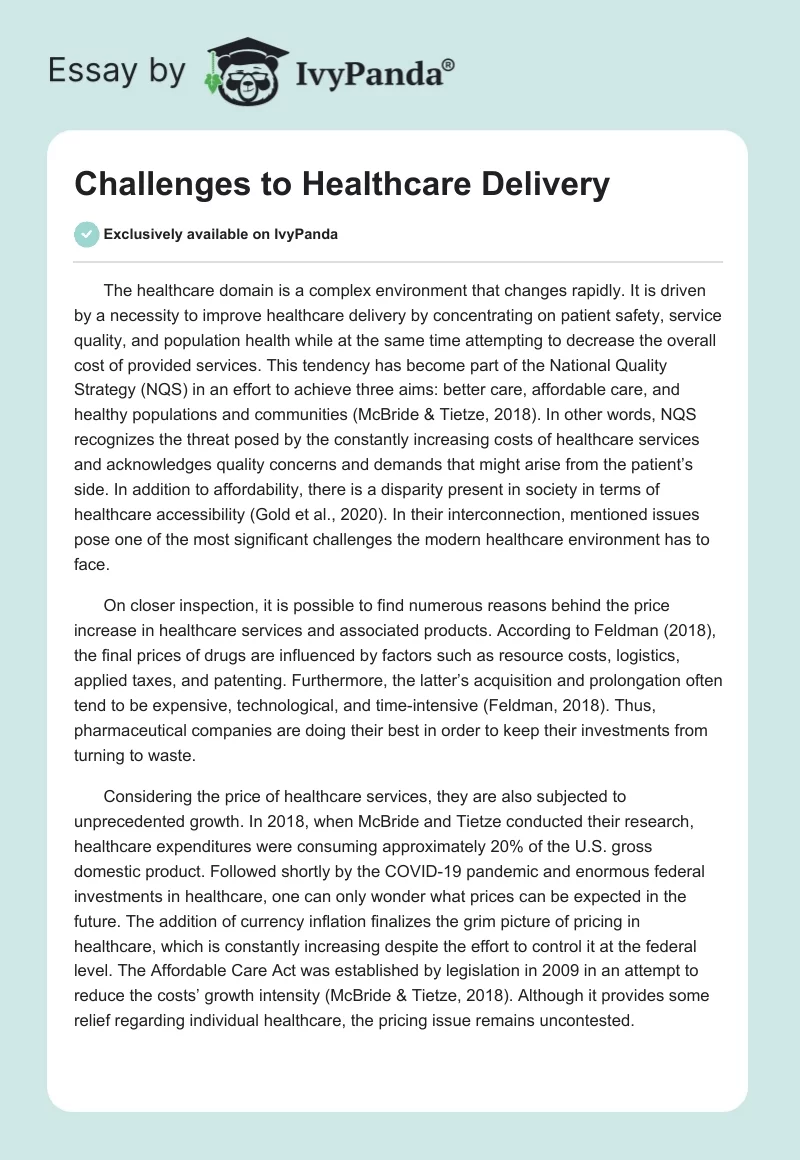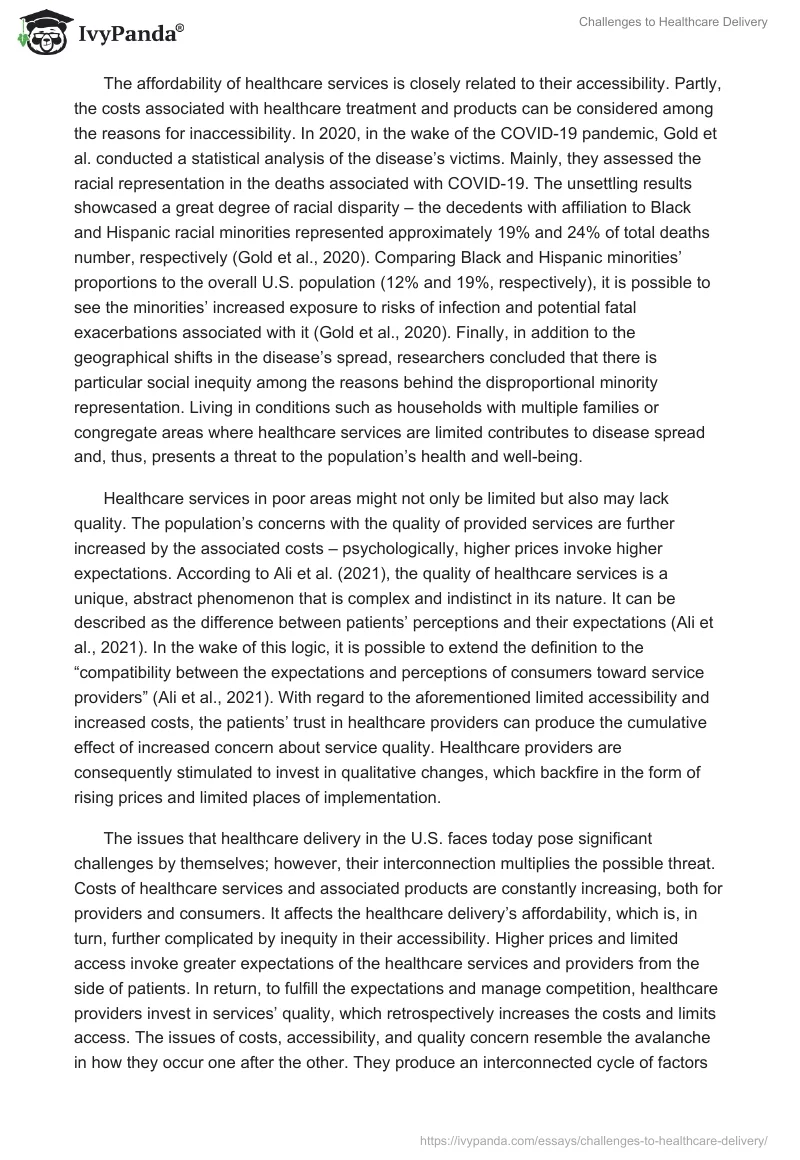The healthcare domain is a complex environment that changes rapidly. It is driven by a necessity to improve healthcare delivery by concentrating on patient safety, service quality, and population health while at the same time attempting to decrease the overall cost of provided services. This tendency has become part of the National Quality Strategy (NQS) in an effort to achieve three aims: better care, affordable care, and healthy populations and communities (McBride & Tietze, 2018). In other words, NQS recognizes the threat posed by the constantly increasing costs of healthcare services and acknowledges quality concerns and demands that might arise from the patient’s side. In addition to affordability, there is a disparity present in society in terms of healthcare accessibility (Gold et al., 2020). In their interconnection, mentioned issues pose one of the most significant challenges the modern healthcare environment has to face.
On closer inspection, it is possible to find numerous reasons behind the price increase in healthcare services and associated products. According to Feldman (2018), the final prices of drugs are influenced by factors such as resource costs, logistics, applied taxes, and patenting. Furthermore, the latter’s acquisition and prolongation often tend to be expensive, technological, and time-intensive (Feldman, 2018). Thus, pharmaceutical companies are doing their best in order to keep their investments from turning to waste.
Considering the price of healthcare services, they are also subjected to unprecedented growth. In 2018, when McBride and Tietze conducted their research, healthcare expenditures were consuming approximately 20% of the U.S. gross domestic product. Followed shortly by the COVID-19 pandemic and enormous federal investments in healthcare, one can only wonder what prices can be expected in the future. The addition of currency inflation finalizes the grim picture of pricing in healthcare, which is constantly increasing despite the effort to control it at the federal level. The Affordable Care Act was established by legislation in 2009 in an attempt to reduce the costs’ growth intensity (McBride & Tietze, 2018). Although it provides some relief regarding individual healthcare, the pricing issue remains uncontested.
The affordability of healthcare services is closely related to their accessibility. Partly, the costs associated with healthcare treatment and products can be considered among the reasons for inaccessibility. In 2020, in the wake of the COVID-19 pandemic, Gold et al. conducted a statistical analysis of the disease’s victims. Mainly, they assessed the racial representation in the deaths associated with COVID-19. The unsettling results showcased a great degree of racial disparity – the decedents with affiliation to Black and Hispanic racial minorities represented approximately 19% and 24% of total deaths number, respectively (Gold et al., 2020). Comparing Black and Hispanic minorities’ proportions to the overall U.S. population (12% and 19%, respectively), it is possible to see the minorities’ increased exposure to risks of infection and potential fatal exacerbations associated with it (Gold et al., 2020). Finally, in addition to the geographical shifts in the disease’s spread, researchers concluded that there is particular social inequity among the reasons behind the disproportional minority representation. Living in conditions such as households with multiple families or congregate areas where healthcare services are limited contributes to disease spread and, thus, presents a threat to the population’s health and well-being.
Healthcare services in poor areas might not only be limited but also may lack quality. The population’s concerns with the quality of provided services are further increased by the associated costs – psychologically, higher prices invoke higher expectations. According to Ali et al. (2021), the quality of healthcare services is a unique, abstract phenomenon that is complex and indistinct in its nature. It can be described as the difference between patients’ perceptions and their expectations (Ali et al., 2021). In the wake of this logic, it is possible to extend the definition to the “compatibility between the expectations and perceptions of consumers toward service providers” (Ali et al., 2021). With regard to the aforementioned limited accessibility and increased costs, the patients’ trust in healthcare providers can produce the cumulative effect of increased concern about service quality. Healthcare providers are consequently stimulated to invest in qualitative changes, which backfire in the form of rising prices and limited places of implementation.
The issues that healthcare delivery in the U.S. faces today pose significant challenges by themselves; however, their interconnection multiplies the possible threat. Costs of healthcare services and associated products are constantly increasing, both for providers and consumers. It affects the healthcare delivery’s affordability, which is, in turn, further complicated by inequity in their accessibility. Higher prices and limited access invoke greater expectations of the healthcare services and providers from the side of patients. In return, to fulfill the expectations and manage competition, healthcare providers invest in services’ quality, which retrospectively increases the costs and limits access. The issues of costs, accessibility, and quality concern resemble the avalanche in how they occur one after the other. They produce an interconnected cycle of factors that negatively influence healthcare delivery, thus, proving the urge to be addressed as quickly as possible.
References
Ali, J., Jusoh, A., Abbas, A. F., & Nor, K. M. (2021). Global trends of service quality in healthcare: A bibliometric analysis of scopus database. Journal of Contemporary Issues in Business and Government Vol, 27(1).
Feldman, R. (2018). May your drug price be evergreen. Journal of Law and the Biosciences, 5(3), 590-647. Web.
Gold, J., Rossen, L. M., Ahmad, F. B., Sutton, P., Li, Z., Salvatore, P. P., Coyle, J. P., DeCuir, J., Baack, B. N., Durant, T. M., Dominguez, K. L., Henley, S. J., Annor, F. B., Fuld, J., Dee, D. L., Bhattarai, A., & Jackson, B. R. (2020). Race, ethnicity, and age trends in persons who died from COVID-19 – United States, May-August 2020.MMWR. Morbidity and mortality weekly report, 69(42), 1517–1521. Web.
McBride, S., & Tietze, M. (2018). Nursing informatics for the advanced practice nurse: Patient safety, quality, outcomes, and interprofessionalism (2nd ed.). Springer Publishing Company.


